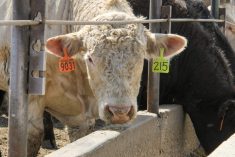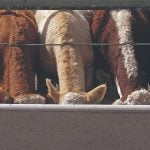Updated, Sept. 30 — With livestock producers’ needs at top of mind, 10 more student seats at the Western College of Veterinary Medicine at the University of Saskatchewan will be spoken for starting next year.
The college and the Saskatchewan and Manitoba governments on Thursday announced the two provinces will each step up their funding commitments to the college, raising the number of subsidized seats for new students each year.
Saskatchewan, which until now has subsidized 20 new students per year, will raise that number to 25 starting in 2023-24, and Manitoba’s count will increase to 20, up from 15, at the same time.
Read Also

Ample supplies and improved livestock sector to boost Canadian feed sector: FCC
Abundant feed grain supplies and improved profitability for the livestock sector should support strong feed demand and sales through the winter, says a new report from Farm Credit Canada.
British Columbia already announced this spring that it would double its subsidized seat count at WCVM to 40 starting in 2022-23.
Veterinary schools in Canada serve defined geographic regions, and only students who meet the residency requirements in those regions can apply to attend. The terms of the cost-sharing interprovincial agreement (IPA) between Saskatchewan, Manitoba and B.C. for WCVM cover provincial enrolment quotas and the residency status of applicants to the college.
As of next year the expansions will bring the agreed-upon total of subsidized IPA seats at WCVM to 88, also including one from the three northern territories and two Indigenous students through the college’s education equity program.
Alberta had been a party to the WCVM IPA until 2020, when it stepped out of the partnership and reallocated that support to its veterinary program at the University of Calgary.
The WCVM until now has had 20 non-subsidized, non-IPA seats, which give preference to students from the three partner provinces but are also open to residents of the territories or Alberta if they’re not filled by Saskatchewan, B.C. or Manitoba residents.
A WCVM representative said via email that the college will advertise those 20 non-IPA seats as available until it confirms whether B.C. plans to maintain its IPA quota at 40 beyond 2022-23.
“The provinces’ support allows more students from Saskatchewan and Manitoba to achieve their dreams of a career in veterinary medicine,” WCVM dean Dr. Gillian Muir said in a release. “It’s also a sound investment in protecting the health and wellness of all animals — from companion animals and wildlife to livestock that play a critical role in Canada’s agriculture industry and the country’s economy.”
Factors including a “rapid increase” in pet ownership, more veterinary professionals reaching retirement age and a “limited number of graduates each year” have led to shortages of veterinarians and registered vet techs across Canada, the college said.
That shortage is more glaring in rural communities, where vet clinic service is essential for livestock producers and the ag industry.
Manitoba’s ag minister Derek Johnson, in a separate release, said that province’s additional seats will be “targeted for the support of commercial livestock, such as cattle, bison and pigs as well as sheep and goats, in rural areas to address this critical labour market need.”
Saskatchewan didn’t say whether its new seats would specifically favour livestock vets, but did say the increase would “help address the growing need for veterinarians across the province, particularly for large animal and mixed animal veterinarians in rural Saskatchewan.”
In 2022-23, Saskatchewan is providing $11.9 million to the WCVM, with an additional investment of $539,000 in 2023-24, which over the four-year veterinary medicine program will mean an increase of $2.2 million by 2026-27 over 2022-23, the province said.
Manitoba, meanwhile, said its funding contribution to WCVM will increase by $539,200 for 2023-24 to a total of $7,009,600, in turn bringing its total contribution in 2024-25 to $7,642,400.
“Increasing the number of students who can attend vet school and enter the profession is the logical first step in addressing the veterinary shortage,” Michelle Streeter, a fourth-year WCVM student from rural Manitoba, said in that province’s release Thursday.
“I am also hopeful that Manitoba’s decision to increase seats draws more students from the Prairies who are interested in working in rural mixed animal practice, since agriculture is such an integral part of so many local communities.” — Glacier FarmMedia Network
















